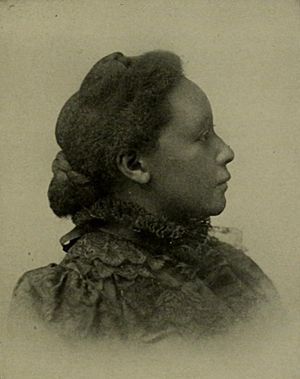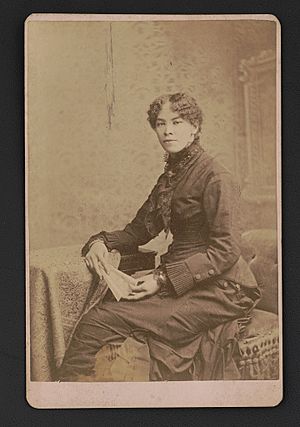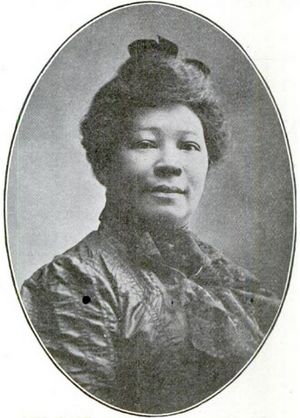Josephine Silone Yates facts for kids
Quick facts for kids
Josephine Silone Yates
|
|
|---|---|
 |
|
| Born | 1852 or November 15, 1859 Mattituck, New York, U.S.
|
| Died | September 3, 1912 Kansas City, Missouri, U.S.
|
| Nationality | American |
| Alma mater | Rhode Island State Normal School, later named Rhode Island College, Rhode Island |
| Known for | The first Black woman to head a college science department and the first Black woman to hold a full professorship at any U.S. college or university |
| Children | 2 |
| Scientific career | |
| Fields | Chemistry, education |
| Institutions | Lincoln University in Jefferson City, Missouri |
|
Josephine Silone Yates
|
|
|---|---|
| Pen name | Mrs. R. K. Potter |
| Occupation | Magazine correspondent and active member of the African American women's club movement |
| Period | 1880s-1906 |
| Subject | racial uplift, poetry, women's issues |
Josephine Silone Yates (born 1852 or November 15, 1859 – died September 3, 1912) was an important American teacher, writer, speaker, and activist. She studied chemistry and became one of the first Black professors at Lincoln University in Jefferson City, Missouri. When she was promoted, she became the first Black woman to lead a college science department. She might also have been the first Black woman to be a full professor at any U.S. college or university.
Yates also wrote for newspapers and magazines, sometimes using the pseudonym (pen name) Mrs. R. K. Potter. She helped Black women improve their lives and standing in society. For example, she wrote for Woman's Era, which was the first monthly magazine published by Black women in the United States. She also wrote for other papers like Omaha, Nebraska's Enterprise.
Yates was a key leader in the African-American women's club movement. She helped start women's clubs for African-American women. She founded and was the first president of the Kansas City Colored Women's League (1893). She also served as the second president of the National Association of Colored Women from 1900 to 1904.
Contents
Early Life and Education
Josephine Silone was born either in 1852 or on November 15, 1859. She was the second daughter of Alexander and Parthenia Reeve Silone in Mattituck, New York. As a child, she lived with her grandfather, Lymas Reeves, who had been freed from slavery in 1813.
Josephine started school at age six and quickly moved ahead in her classes. By age nine, she was already studying physiology and physics. She was also very good at math. At this young age, she even sent a story to a New York magazine. Although it wasn't published, she received an encouraging letter, which made her want to succeed even more.
When she was 11, Josephine went to live with her uncle, Rev. John Bunyan Reeve, in Philadelphia. She attended the Institute for Colored Youth there. Its director, Fanny Jackson Coppin, became her mentor. The next year, her uncle moved, so Josephine went to live with her aunt in Newport, Rhode Island. She attended grammar school and then Rogers High School. Josephine was the only Black student at both schools. Her teachers liked her because she was so smart. Her science teacher thought she was his best student and let her do extra lab work in chemistry. In 1877, Josephine was the first Black student to graduate from Rogers High School. She was the valedictorian (top student) of her class and won a medal for her excellent grades.
Instead of going to a university, Silone decided to attend the Rhode Island State Normal School in Providence to become a teacher. She graduated with honors in 1879. She was the only Black student in her class. She became the first African American certified to teach in Rhode Island schools. Later, she earned a master's degree from the National University of Illinois.
Teaching Career
In 1879, Josephine Silone moved to Jefferson City, Missouri. She became one of the first Black teachers hired at Lincoln University. The university president, Inman Edward Page, wanted Black teachers to be role models for the African-American students. Teachers lived on campus in the dorms with the students. Josephine taught chemistry, public speaking, and English literature.
When she was promoted to lead the natural science department, she made history. She became the first Black woman to head a college science department. She was also the first Black woman to hold a full professorship (a top teaching position) at any U.S. college or university.
In 1886, she was offered a job as "lady-principal" at Tuskegee Institute in Alabama. This school was led by Booker T. Washington. However, she chose not to take the job.
Josephine Silone Yates had a clear idea about why she taught. In an essay from 1904, she wrote: "The goal of all true education is to give the body and soul all the beauty, strength, and perfection they can have. It is to prepare a person for a complete life."
Marriage and Family Life
In 1889, Josephine Silone married William Ward Yates. At that time, many schools did not allow married women to teach. So, when she got married, Josephine Silone left her teaching job at Lincoln University. She moved to Kansas City, Missouri, where her husband was the principal of Phillips School. Their daughter, Josephine Silone Yates, Jr., was born in 1890. Their son, William Blyden Yates, was born in 1895.
Writing as Mrs. R.K. Potter
In Kansas City, Yates became very involved in the African-American women's club movement. She wrote for Woman's Era, the first monthly magazine published by Black women in the United States. She also wrote for other publications like the Southern Workman and The Voice of the Negro. She used her own name and the pen name "R. K. Porter."
One of the main topics she wrote and spoke about was "racial uplift." This meant helping Black people improve their lives and standing in society. In 1902, she was named one of 100 of "America's greatest Negroes" in a book called Twentieth Century Negro Literature. She wrote about whether African Americans had achieved success in wealth, morality, and education during the 1800s. She also wrote poetry, including "The Isles of Peace" and "Royal To-Day."
The Women's Club Movement
Josephine Silone Yates helped create the Women's League of Kansas City in 1893. This group aimed to help African-American women and improve their social lives. She became its first president. In 1896, the Women's League joined the National Association of Colored Women (NACW). This was a large group of similar clubs from all over the country. Silone Yates served as the treasurer or vice-president of the NACW from 1897 to 1901. Then, she was president from 1901 to 1904. By 1911, she had also helped start the first Black YWCA in Kansas City.
Her achievements were praised by others. For example, Anna Julia Cooper gave a speech in 1893 at the World's Congress of Representative Women in Chicago. She said:
In organized efforts for self help and kindness, our women have also been active. The Colored Women's League, which I am currently the secretary for, has active branches in the South and West. The branch in Kansas City, with over one hundred and fifty members, has already started building a home for girls who need help, under their strong president, Mrs. Yates.
Later Life
In 1902, the president of Lincoln Institute asked her to return. She came back to lead the English and history department. In 1908, she asked to resign because she was ill. However, the school's Board of Regents did not accept her resignation. So, she stayed on as an advisor to the women students at Lincoln. Her husband died in 1910. After his death, Josephine Silone Yates decided to move back to Kansas City. She passed away on September 3, 1912, after a short illness.
See also



